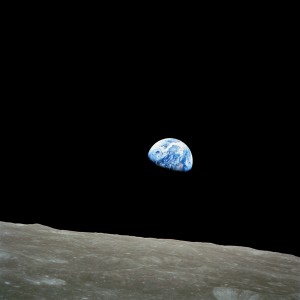In 1968 over the Christmas holidays, three Americans orbited the moon for the first time. It is the incredible story of Apollo 8 crewed by Commander Frank Borman, James Lovell serving as the Command Module Pilot, and William Anders piloting the Lunar Module. The mission launched on December 21, 1968, took three days to reach the moon, and orbited the lunar orb 10 times over a period of 20 hours. Splashdown at the end of the mission occurred in the northern Pacific Ocean on December 27.
Sixty-nine hours, 8 minutes and 16 seconds after lift-off, the Service Propulsion System (SPS) engine ignited for precisely four minutes, 13 seconds. The timing was critical for both the start and length of the burn to put the spacecraft into proper orbit around the moon. If the timing was off, if the mathematical calculations incorrect, whatever the reason, there was a possibility the craft with her precious human cargo could have missed the lunar orbit and ricocheted into space. The other option was crashing into the surface of the moon. Neither happened because the math was correct and the engine burn timed flawlessly.
For a brief time, Borman, Lovell, and Anders were the only humans to have travelled so far from the earth. They were the first to witness the universe as it truly was created. When Lovell described the moon after he had a chance to look at the surface and report to Mission Control, he said, “The Moon is essentially grey, no color; looks like plaster of Paris or sort of a grayish beach sand. We can see quite a bit of detail. The Sea of Fertility doesn’t stand out as well here as it does back on Earth. There’s not as much contrast between that and the surrounding craters. The craters are all rounded off. There’s quite a few of them, some of them are newer. Many of them look like—especially the round ones—look like hit by meteoritesor projectiles of some sort. Langrenus is quite a huge crater; it’s got a central cone to it. The walls of the crater are terraced, about six or seven different terraces on the way down.”
One reason for their trip to the moon was to scout out possible landing areas for the first lunar landing, schedule a little more than six months in the future. To accomplish this reconnaissance and preserve the information, the craft was equipped with many cameras for both black & white and color photography, as well as for transmitting live images back to earth.
During the first two lunar orbits, the spacecraft was oriented in such a way that did not allow the crew to see the earth. On the third orbit, they rotated the craft and during the third orbit, the crew lost their collective breath when they became the first human beings ever to witness earthrise.
Lovell alerted the others and began taking B&W photos at the same time. It was Anders who shot the most famous color photograph that Life magazine named as one of the most important images of the century.
On their ninth orbit of the lunar surface, they began their second television transmission to earth. Borman introduced the crewmembers and each gave an impression of what they were seeing on the face of the moon. Borman portrayed the moon as “a vast, lonely, forbidding expanse of nothing.”
After each man verbalized his description of the moon, Anders told the world the crew had a message for everyone on earth. The three men then read sections of the first ten chapters of the Book of Genesis from the Bible. Borman finished the broadcast by saying, “And from the crew of Apollo 8, we close with good night, good luck, a Merry Christmas and God bless all of you—all of you on the good Earth.”
All these years later, 45 to be precise, the message of Apollo 8 still holds true. Additionally, with the technology developed over the last four decades, the mission, and earthrise, can be viewed by all today through the magic of YouTube. For your pleasure, check out, “NASA | Earthrise: The 45th Anniversary.” (Found at https://www.youtube.com/watch?v=dE-vOscpiNc.)
©2013 J. Clark
Note: Email subscribers, please go to my blog to view vids

